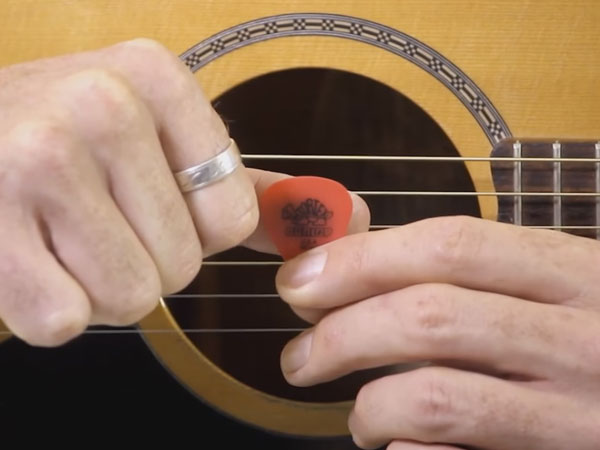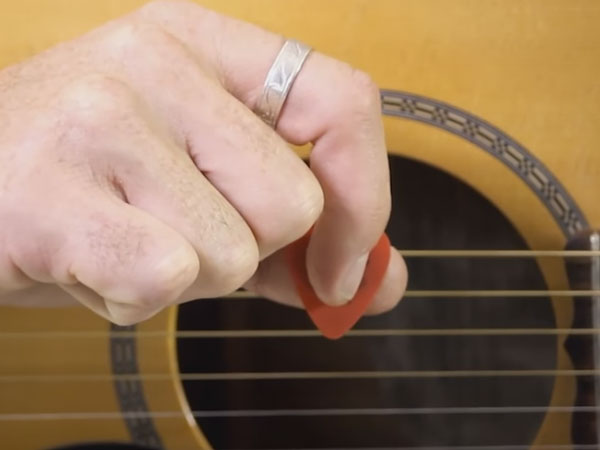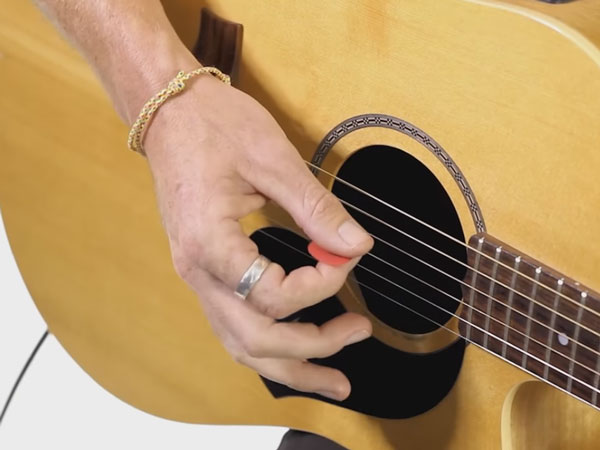Do you know how to hold a guitar pick properly? In this lesson, I show you exactly how to hold and use a guitar pick in 3 easy steps. Most guitarists I show this to are shocked to find they’ve been holding the pick the wrong way for years, and can hardly believe the change that holding the pick correctly makes to their playing.
Video Lesson: How to Hold a Guitar Pick
How to Hold a Guitar Pick
Step 1
Thumb Middle
Put your thumb across one side of the pick. Make sure the thumb is centered and over-hanging the pick, so you can see the tip of your thumb poking out the side.

Step 2
Index Finger Pointing Down
Place your index finger (the side, not the fleshy part) on the other-side of the pick, pointing down the pick. Make sure the index finger isn’t poking out beyond the tip of the pick. Relax your index finger and give it a bit of curvature.

Step 3
Relax in the A-OKAY Position
Lastly, relax your hand and let in go naturally into the A-OKAY position. Your fingers and hand should feel relaxed.

Troubleshooting
The pick keeps sliding around in my fingers. How do I stop this?
Okay, first of all, this is normal. It happens to me, it happens to all guitar players. You are going to get movement. Think about it, you’re essentially hitting your guitar strings with the pick. There’s going to be some push back. So the trick is not to try and stop this pick movement, not to try and be so rigid that the pick doesn’t move, that’s not realistic, the pick will still move. No, the trick is to work with the movement of the pick. Work with the pick and the strings of the guitar to constantly correct the pick’s position between your thumb and forefinger.
Sounds difficult right? Well, it is for a start. Especially, if you’re thinking about it too much. If you’re constantly focusing on the pick, where it is and where you want it to be, it will make playing very difficult. But if you get your position right from the outset, and focus on strumming with your entire arm, eventually you will get to the point where you automatically make the necessary adjustments to keep the pick in position, without thinking about it.
It takes practice, and if you’re just starting out, you’re going to drop the pick a lot. That’s okay. I’d rather you drop the pick a whole bunch of times than you hold on to it too tightly and become rigid. Remember, in playing guitar, relaxed movement is best.
Some things you can do to help yourself:
Make sure your thumb is in the correct position. The thumb is really what keeps the pick from moving out of control. So you need to have plenty of thumb over the pick. If you’re having trouble with the pick sliding around, check your thumb. Make sure it’s positioned right across the back of the pick and overshoots it some.
Try a lighter gauge of pick. Pick movement occurs when your pick and fingers flex and move to accommodate some of the impact from you hitting your guitar strings. The harder the pick, the less flex you get. With a hard pick, your fingers end up taking more impact, which leads to a loosened grip on the pick. A lighter pick provides more flex, so there’s less shock on your fingers, and you’re less likely to loose your grip. If you’re struggling to hold on to the pick you’ve got, try some lighter gauge picks. A 0.60mm is a good place to start. See how it feels and move up or down the grade accordingly.
Try a grippy pick. Some picks are smooth and some are grippy. I recommend starting with a grippy pick like the Jim Dunlop Nylon Standard pick which comes with a moulded gripping surface.
What angle should the pick be on when I pick the strings?
So there are really two angles to talk about when it comes to picking and they both come from the wrist. The first one is the angle of the tip of the pick away from the strings as you strum up or down, and it comes from subtly rotating your wrist while you strum. So for example, in the down strum, you should angle the tip of the pick slightly up, so it’s not straight on, and definitely not pointing at the guitar strings which would cause you to get caught up in the strings. On the up strum it’s the exact opposite. The pick is angled slightly down. These angles are created by the slight rotation of your wrist, left for the up stroke, and right for down. So that’s the first angle to think about.
The second angle is that created by sideways rotation of the pick which is actually created by a downward angling of the wrist. By angling the wrist forwards and down, you’ll start to use the rounded edge of the pick against the strings, rather than the flat tip. Because this angle reduces friction between pick and strings, you’ll find it easier on your fingers, and it actually sounds better too. On the down strum, you’ll use the bottom edge of the pick, and on the up stroke you’ll be using the top edge.
Sometimes I hold the pick with thumb and two fingers. Is this wrong?
In this instance, you haven’t got enough thumb on the pick. That is why you feel the need to bring another finger up on to the pick to add support. When holding a pick, your thumb needs to act like a solid wall.
Imagine you want to nail a picture to a wall. Would you place the picture half on, half off the wall, and only attach it on one side? Of course not. The picture would fall off in no time. No, you need support. You’d put the picture in the middle of the wall and attach it on both sides. Then you’d have proper adhesion.
This is what your thumb provides when you put it right across the back of the pick. It provides a lot of surface area for the pick to stick to.
Do I need to hold it different when I strum?
No, if you’re holding it correctly as shown above, you will be able to strum and pick single notes with no problems at all.
When I use a pick to strum, I often clip the nail on my index finger. It ends up getting worn down on the right hand side. Should I worry about this?
This is quite normal. I have it, and many other guitarists get this too. It comes about from having your finger very close to the tip of the pick. The good thing about doing this is that your fingers are closer to the strings and you’ll experience more control and a sense of connection with the strings. The downside is that your finger nail will get worn down some. If it concerns you, you can just hold the pick back a little to give yourself more pick between you and the strings.
I hold the pick between my thumb and knuckle of my index finger. Is this wrong?
The first thing I have to say about this is: holding the pick at the knuckle is ugly as hell. But, if this is how you do it, and it works for you, who am I to stop you. The second thing is this: if you are starting out, please don’t learn to hold a pick like this. Sure, you might find some examples of people who do it and who play well. But it’s not because of their picking technique, it’s in spite of it. We’ve moved on from not knowing the best way to hold a guitar pick. Learn it the right way, it’s much easier.
Also, I’ve seen too many guitarists with bleeding knuckles from this very thing… not pretty.
What gauge of pick do you recommend?
There’s no rule when it comes to selecting pick thickness. I recommend you go to your local guitar store and get a range of gauges and try them out. They’re only a dollar folks – it’s not like we’re buying a $300 guitar pick, so we have to get it right first time. No, picks are inexpensive. So take twenty bucks down to your local music store and buy a stack of different options. Over the course of a year you’ll lose half of them (or more likely your mates will nick off with them,) you’ll change preferences, and you’ll find a favorite that you’ll treasure forever (‘it’s my precious).
For total beginners I recommend you start with a 0.60mm pick with plenty of grip. This gives you the best of both worlds – not so flexible that you lose control, and not so rigid that you keep getting stuck in your strings.
What do you think of this article? Did we miss anything out? Please leave a comment below.


If your picking hand feels “unsure” when you play and you have a hard time picking the correct string when you play, this lesson is surely going to help attain a feeling of stability in your hand and it will be much easier for you to play the correct string at the correct time. Thanks
This is really helpful. For the beginning guitar players who have a great deal of difficulty picking individual guitar strings with accuracy and control this post is thumbs up.
My mod work:
http://joni.web.telrock.net
Thanks a lot, Mark!!! I’ve learned to hold pick with your article!
Dear Mark, I am a beginner, and I had been holding my pick incorrectly. Thank you so much for this video. And your “pressing technique” for learning chords is sheer genius. You are my #1 favorite teacher, and boy have I been searching!
Do you accept requests? My greatest hope is to be able to play an Ani Difranco song one day. I have not found any decent video instructions for any of her songs on youtube. Is there any chance you could teach one of her songs? I’m still trying to decide which one I’d like best to know…
GK